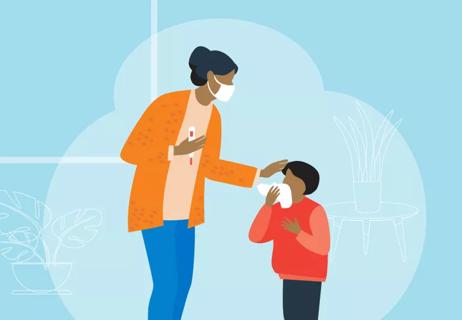Use a digital oral, rectal, axillary, ear or forehead thermometer based on your child’s age

Your kid seems tired, cranky and out of sorts. Their forehead feels hot to your hand, so you decide to check if they have a fever. What type of thermometer should you use and how should you take their temperature to make sure it’s most accurate? Pediatric nurse practitioner Melanie Klein, CNP, breaks down which thermometers to use for kids of any age.
Advertisement
Cleveland Clinic is a non-profit academic medical center. Advertising on our site helps support our mission. We do not endorse non-Cleveland Clinic products or services. Policy
The accuracy of a thermometer is largely affected by your child’s ability to allow for the use of the right tool for the job.
“Older children and teens can use an oral digital thermometer without difficulty, but infants and young children don’t have the motor skills or patience to get an accurate reading from that kind of thermometer,” says Klein.
When considering which thermometer to use, there are several options to choose from.
These thermometers read your body temperature through the small metal tip at the end of the thermometer. They’re quick, easy and inexpensive. By placing the tip under your child’s tongue, in their armpit (axillary) or inserting it rectally, the thermometer can pick up your kid’s temperature with varying degrees of success.
Using the axillary (armpit) method will be the least accurate method because it’s not measuring your kid’s temperature from the inside of their bodies. Plus, most axillary skin and tissue aren’t close enough to major blood vessels to get an accurate reading. If you do an axillary temperature reading, you’ll want to add 1/2 to 1 degree Fahrenheit (.3 to .6 degrees Celsius) for a more accurate reading.
For children 3 years old and younger, a rectal temperature is the most accurate for a standard digital thermometer. For kids 4 and up, an oral temperature reading is most accurate.
Advertisement
“You should have separate oral and rectal thermometers and they should be labeled to prevent cross-contamination,” advises Klein.
Digital ear thermometers use infrared technology to capture the temperature of your eardrum. These are most helpful if your child is 6 months to 1 year of age.
Though less invasive than a rectal temperature reading and easier for older kids, you want to make sure your kid’s ear canal isn’t blocked up with ear wax and that you’re able to insert the thermometer effectively.
“You don’t want to use this to check their temperature shortly after coming in from the cold because it might not be accurate,” notes Klein. “Instead, wait five to 10 minutes until they’re warmed up and acclimated to the room temperature before using this thermometer.”
Similar to ear thermometers, these use infrared technology to measure heat waves coming off your kid’s temporal artery. This major artery runs across the middle of your forehead just below the surface of your skin. Like the axillary method, it’s not as reliable as a rectal or oral temperature reading, but it can be used for kids 3 months and older. Keep in mind, if your child is sweating or has just come in from outside, that could affect the accuracy of this temperature reading, too.
There are some thermometers you never want to use when checking your child’s temperature. These include:
A normal body temperature is about 98.6 F (or 37 C). A fever is considered to be a temperature of 100.4 F (38 C) or above.
You can treat a fever at home with a fever reducer medication and fluids to make your child more comfortable, or let it run its course. But if your kid’s temperature reaches 102 F (38.8 C) or higher, and home treatment doesn’t lower it, you should call your healthcare provider.
Advertisement
Here are steps you should take to get the most accurate temperature reading for each thermometer. Before following these steps, it’s important you also read the instructions that come with each instrument before using them.
Advertisement
Advertisement
“If you’re not sure if you have the right thermometer, talk with your pediatrician or healthcare provider who can point you in the right direction,” says Klein.
Learn more about our editorial process.
Advertisement

It’s important not to give them fever-reducing medications right off the bat

Get some rest, drink fluids, use blankets or ice packs and take medications

Behavior and age are important clues

What you need to know about these common misconceptions

When undergoing cancer treatment, fever is a critical symptom to address

The short answer from a primary care physician

When symptoms call for a trip to the doctor

Keeping your baby’s airways clear of mucus helps with breathing and feeding

Learn the benefits of a morning meal, plus five healthy food ideas to start your day right